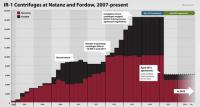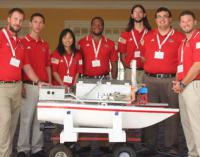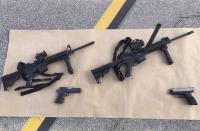-
Most guns recovered by Pittsburgh police not in possession of legal owners
Nearly 80 percent of perpetrators carrying a gun recovered by Pittsburgh Police were not the lawful owners, a strong indication that theft and trafficking are significant sources of firearms involved in crimes in southwest Pennsylvania, a new study finds. The finding suggests a timely opportunity for collaboration between public health and law enforcement officials better to understand and reduce violent crimes involving firearms.
-
-
Studying the basic science of nuclear waste
Approximately 300 million liters of highly radioactive wastes are stored in hundreds of underground tanks at the Hanford Site in Washington and the Savannah River Site in South Carolina. These wastes are extremely complicated mixtures of salts and sludges that have been exposed to ionizing radiation for decades. Their chemistry is dominated by interactions at solid-liquid interfaces that are poorly understood. A more thorough understanding of the chemistry of radioactive waste is key to treating this unwanted byproduct of winning the Second World War and the cold war.
-
-
Hazmat Challenge tests skills of hazardous materials response teams
Ten hazardous materials response teams from New Mexico, Missouri, Oklahoma, and Nebraska test their skills in a series of graded, timed exercises. The event requires participants to respond to simulated hazardous materials emergencies involving aircraft, rail and highway transportation, industrial piping, a simulated radiological release, and a confined space event.
-
-
Syrian asylum-seeker who blew himself up in Ansbach, Germany, was about to be deported
A 27-year old Syrian refugee whose asylum application had been denied, and who was about to be deported to Bulgaria, blew himself up Sunday evening outside a wine bar in the Bavarian town of Ansbach. Twelve people were injured in the explosion, three of them seriously. The past week was a particularly violent week in Germany, with a 21-year-old Syrian refugee knifing a woman to death in the city of Reutlingen on Sunday, and a mentally unstable 17-year old German teenager of Iranian descent, who was obsessed with mass shooting, killing nine people on Friday in a shopping mall in Munich, before turning his gun on himself.
-
-
Report: Next war with Hezbollah could cause “thousands of civilian deaths” in Israel

Israeli officials believe that a future war with Hezbollah, with its advanced Iranian-supplied rocket arsenal, could lead to “thousands of civilian deaths,” according to a new study. Hezbollah is now believed by Israel to possess about 150,000 rockets, which exceeds the combined arsenals of all non-U.S. NATO countries and is ten times larger than its arsenal before the 2006 war.
-
-
Separating the DNA of identical twins
Since its first use in the 1980s — a breakthrough dramatized in recent ITV series “Code of a Killer” — DNA profiling has been a vital tool for forensic investigators. Now researchers at the University of Huddersfield have solved one of its few limitations by successfully testing a technique for distinguishing between the DNA — or genetic fingerprint — of identical twins.
-
-
Secret side deal cuts Iran’s breakout time in half in little more than a decade

Key restrictions on Iran’s nuclear program will ease in slightly more than a decade, cutting in half the time Iran would need to build a nuclear weapons. The AP had obtained a document from a source inside the IAEA — a document which was the only secret portion to last year’s agreement between Iran and the P5+1 powers. The document said that after a period of between eleven to thirteen years, Iran could replace its 5,060 older, and inefficient, centrifuges with up to 3,500 advanced centrifuges.
-
-
U.K. reviews security measures for large outdoor events
Amber Rudd, the new British home secretary, told the House of Commons that she has ordered a full review of the security measures taken to protect large outdoor events such as festivals and other public gatherings. The review comes in the wake of the attack in Nice on revelers celebrating Bastille Day. Rudd said that additional security measures will be put in place, including what is known as the “national barrier asset” when police assess that there is a risk of vehicle attacks.
-
-
3D printing: a new threat to gun control and security policy?
The threat of self-manufactured firearms is not new, but a critical barrier is collapsing. Until recently, most people did not have the skills to make a weapon as capable as commercially available ones. However, recent developments in the field of additive manufacturing, also known as 3D printing, have made home manufacturing simpler than ever before. The prospect of more stringent gun safety legislation is also fueling interest in at-home production. The worst threats 3D printing poses to human life and safety are likely some distance in the future. However, the harder policymakers and others work to restrict access to handguns or unconventional weapons, the more attractive 3D printing becomes to those who want to do harm.
-
-
DHS report highlights R&D priorities for technologies used in the field

The Department of Homeland Security has released the Integrated Product Teams for Department of Homeland Security R&D Fiscal Year 2016 Report. The report identifies twenty-four focus areas for technological research and development (R&D), which fall under five mission areas: aviation security, biological threats, border security, cybersecurity, and counterterrorism.
-
-
The future of naval force and RoboBoats

The future of naval engineering was on display earlier this month, as thirteen teams of high school and college students did battle at the ninth annual RoboBoat Competition in Virginia Beach, Virginia. The competition is a robotics contest where teams program their student-built autonomous surface vehicles to navigate through a series of water-based challenges.
-
-
Shooter motivated by 1960s-era Black Nationalism

Gavin long, 29, who shot and killed three policemen in Baton Rouge before being fatally shot by the police, appears to have been motivated by 1960s-era Black Nationalism, which called on African Americans to take a strong, even violent, stance against mistreatment by authorities. Long left a long trail of on-line material, both postings and videos. In another video, referring to Native Americans, Long said, “When they were extincted [sic] by the same people that run this country, my question to you, just something you can think about: At what point should they have stood up?”
-
-
Coup attempt raises fresh questions about safety of U.S. nuclear stockpile in Turkey

To the extent that news coverage of the coup attempt in Turkey touched on how the coup might affect the U.S. military presence in the country, the focus was on air operations the United States has been conducting against ISIS from the Incirlik airbase in southern Turkey. What was not discussed in the media was the fact that the base is home to the largest stockpile of U.S. nuclear weapons in Europe. The coup was the cause of fresh questions about the safety of these weapons, and the wisdom of storing them in such a vulnerable location.
-
-
Reducing civilian firepower would boost police, community safety: Expert

A recent study examined data on the number of homicidal deaths of police in two groups of states with roughly equal number of police officers – the eight states with the lowest levels of gun ownership and the twenty-three states with the highest rate of gun ownership. The study found that, over the period from 1996 to 2010, the rate of police homicide in the high-gun prevalence states was three times as high as the rate of police homicide in the low-gun prevalence states. In addition to restricting the firepower a person can amass, a Stanford University expert advocates efforts to build trust between communities and law enforcement agencies as a way to enhance both police and citizen safety.
-
-
Allocation of police resources affects economic urban welfare, inequality
Decisions about how to allocate police resources in a community are likely to influence not only crime but also housing prices, overall economic welfare, and social inequality, according to a new study by economists. The researchers develop a model for examining the behavior of socioeconomic groups in response to two possible strategies: one in which police are concentrated in certain areas and another in which they are dispersed equally across the city. The researchers conclude that equal dispersal of police will lead to a city which is economically integrated, with housing prices comparable from one neighborhood to the next. Concentrating police in certain locations will lead to unequal neighborhoods but may produce greater overall wealth.
-
More headlines
The long view
Factories First: Winning the Drone War Before It Starts
Wars are won by factories before they are won on the battlefield,Martin C. Feldmann writes, noting that the United States lacks the manufacturing depth for the coming drone age. Rectifying this situation “will take far more than procurement tweaks,” Feldmann writes. “It demands a national-level, wartime-scale industrial mobilization.”
How Male Grievance Fuels Radicalization and Extremist Violence
Social extremism is evolving in reach and form. While traditional racial supremacy ideologies remain, contemporary movements are now often fueled by something more personal and emotionally resonant: male grievance.
The Surprising Reasons Floods and Other Disasters Are Deadlier at Night
It’s not just that it’s dark and people are asleep. Urban sprawl, confirmation bias, and other factors can play a role.
Why Flash Flood Warnings Will Continue to Go Unheeded
Experts say local education and community support are key to conveying risk.
